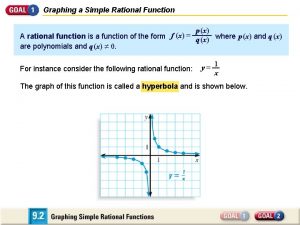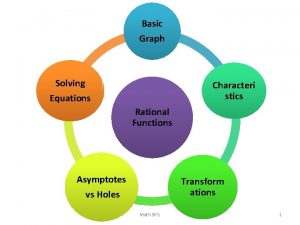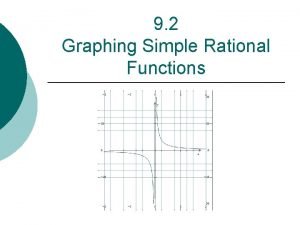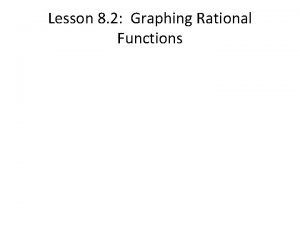GRAPHING RATIONAL FUNCTIONS CONCEPT SUMMARY GRAPHS OF RATIONAL







- Slides: 7

GRAPHING RATIONAL FUNCTIONS CONCEPT SUMMARY GRAPHS OF RATIONAL FUNCTIONS Let p (x ) and q (x ) be polynomials with no common factors other than 1. The graph of the rational function p (x ) f (x ) = = q (x ) a m x m + a m – 1 x m – 1 + … + a 1 x + a 0 b n x n + b n – 1 x n – 1 + … + b 1 x + b 0 has the following characteristics. 1. x - intercepts are the real zeros of p (x ) 2. vertical asymptote at each real zero of q (x ) 3. at most one horizontal asymptote

GRAPHING RATIONAL FUNCTIONS CONCEPT SUMMARY GRAPHS OF RATIONAL FUNCTIONS a m x m + a m – 1 x m – 1 + … + a 1 x + a 0 p (x ) f (x ) = = q (x ) b n x n + b n – 1 x n – 1 + … + b 1 x + b 0 3. at most one horizontal asymptote at each zero of q (x ) • If m < n, the line y = 0 is a horizontal asymptote. am • If m = n, the line y = is a horizontal asymptote. bn • If m > n, the graph has no horizontal asymptote. Its end a m m – n behavior is the same as the graph of y = x . bn

Graphing a Rational Function (m < n) Graph y = 4. State domain x 2 + 1 and range. SOLUTION The numerator has no zeros, so there is no x-intercept. The denominator has no real zeros, so there is no vertical asymptote. The degree of the numerator (0) is less than the degree of the denominator (2), so the line y = 0 (the x-axis) is a horizontal asymptote. The bell-shaped graph passes through (– 3, 0. 4), (– 1, 2), (0, 4), (1, 2), and (3, 0. 4). The domain is all real numbers; the range is 0 < y 4.

Graphing a Rational Function (m = n) 2 3 x Graph y = 2. x – 4 SOLUTION The numerator has 0 as its only zero, so the graph has one x-intercept at (0, 0). The denominator can be factored as (x + 2)(x – 2), so the denominator has zeros at 2 and – 2. This implies vertical asymptotes at x = – 2 and x = 2. The degree of the numerator (2) is equal to the degree of the denominator (2), am so the horizontal asymptote is y = = 3. bn

Graphing a Rational Function (m = n) 2 3 x Graph y = 2. x – 4 To draw the graph, plot points between and beyond vertical asymptotes. To the left of x = – 2 Between x = – 2 and x = 2 To the right of x = 2 x yy – 4 4 – 3 5. 4 – 1 0 0 1 – 1 3 5. 4 4 4

Graphing a Rational Function (m > n) x 2 – 2 x – 3 Graph y =. x+4 SOLUTION The numerator can be factored as ( x – 3) and ( x + 1); the x-intercepts are 3 and – 1. The only zero of the denominator is – 4, so the only vertical asymptote is x = – 4. The degree of the numerator (2) is greater than the degree of the denominator (1), so there is no horizontal asymptote and the end behavior of the graph of f is the same as the end behavior of the graph of y = x 2 – 1 = x.

Graphing a Rational Function (m > n) x 2 – 2 x – 3 Graph y =. x+4 To draw the graph, plot points to the left and right of the vertical asymptote. To the left of x = – 4 To the right of x = – 4 x yy – 12 – 20. 6 – 9 – 19. 2 – 6 – 22. 5 – 2 2. 5 0 – 0. 75 2 – 0. 5 4 0. 63 6 2. 1













